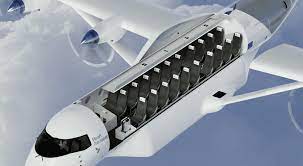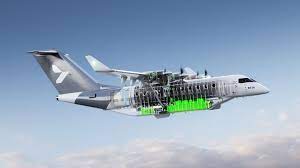German Version below
Norway is a pioneer in the balancing act between customer needs and climate protection: flying yes, but please without CO2 emissions.
From 2040, short-haul flights must be 100 percent electric. With this strict requirement, Norway will become a pioneer for zero-emission mobility in aviation as well, following the radical switch to electric cars. The requirement is to apply to all flights lasting up to one and a half hours, including cross-border connections.
Norway was and is particularly suitable as a real laboratory for electric aviation. Because of its exceptionally inaccessible landscape, the airplane is often the only way for people there to stay connected besides smartphones and the Internet.
Norwegian start-ups or the Swedish company Heart Aerospace are pioneers here. Heart’s ES-300, for example, is scheduled to go into series production as early as 2026 – optimized for short-haul flights without climate impact.
Currently, one of the biggest hurdles is the long battery charging time. What already annoys electric car drivers on long-haul routes would ruin an airline’s business: an aircraft that has to be charged for hours at the destination airport before it can take off again is no use for fast-moving short-haul traffic.
Heart is looking at a different solution: two turbo engines are to be mounted on the tail of their design, which can run on sustainably produced fuel. Because the safety requirements in air traffic are high, reserves must always be available to be able to continue circling in the air for a long time in the event of problems or to fly to an alternative airport.
With the Heart ES-300, these two turbo engines would kick in when needed, increasing the range to 400 kilometers. This would also solve the safety problems. Drivers are familiar with the principle under the term range extender from early electric cars like the first-generation BMW i3. Heart calls it a “reserve hybrid system.

So the promise of clean mobility by air is joined by the hope of a new, small boom in flying, thanks to lower ticket prices. This development is also relevant for Germany, where short-haul flights currently do not enjoy the best reputation. Discontinued short-haul services could be resumed on a climate-neutral basis.
Sources: Der Spiegel, dpa, afp.
Königsweg zu klimaneutralem Fliegen?
Norwegen führt den Weg in Bezug auf die Vereinbarkeit von Kundenbedürfnissen und Klimaschutz an: Fliegen ist weiterhin erlaubt, jedoch auf Kurzstrecken nur ohne Kohlenstoffemissionen.
Ab dem Jahr 2040 müssen alle Kurzstreckenflüge zu 100 % elektrisch betrieben werden. Mit dieser strengen Vorgabe wird Norwegen, nachdem es bereits radikal auf Elektroautos umgestiegen ist, auch in der Luftfahrt zum Vorreiter in Sachen emissionsfreie Mobilität.
Diese Regelung gilt für alle Flüge mit einer Dauer von bis zu anderthalb Stunden, einschließlich grenzüberschreitender Flüge.
Norwegen ist gut darauf vorbereitet, ein wahres Laboratorium für die elektrische Luftfahrt zu werden. Aufgrund der außergewöhnlich zerklüfteten Landschaft und schweren Erreichbarkeit vieler Landesteile ist das Flugzeug oft die einzige Möglichkeit, um mit Menschen in Kontakt zu treten, abgesehen von Smartphones und dem Internet.
Norwegische Start-ups wie auch das schwedische Unternehmen Heart Aerospace sind Pioniere auf diesem Gebiet. Das Modell ES-300 von Heart soll bereits im Jahr 2026 in Serie gehen und speziell für umweltfreundliche Kurzstreckenflüge optimiert sein.
Ein derzeit noch großes Hindernis besteht in der langen Ladezeit der Batterien. Was für Elektroautofahrer auf langen Strecken bereits ärgerlich ist, würde für Fluggesellschaften ein Problem darstellen: Ein Flugzeug, das am Zielflughafen stundenlang aufgeladen werden muss, bevor es starten kann, wäre für den Hochgeschwindigkeitsverkehr auf Kurzstrecken ungeeignet.
Heart denkt über eine alternative Lösung nach: Das Unternehmen plant, zwei Turbomotoren in das Heck seines Modells einzubauen, die mit nachhaltig erzeugtem Treibstoff betrieben werden können. Angesichts der hohen Sicherheitsanforderungen im Luftverkehr muss immer eine Leistungsreserve vorhanden sein, um das Flugzeug für längere Zeit in der Luft zu halten oder bei Problemen auf einen alternativen Flughafen ausweichen zu können.
In der Heart ES-300 würden diese beiden Turbotriebwerke bei Bedarf aktiviert und die Reichweite dadurch auf 400 Kilometer erhöht. So würden auch Sicherheitsprobleme gelöst werden. Autofahrer kennen dieses Prinzip bereits vom “Range Extender” früherer Elektroautos. Heart nennt es”Hybrid-Backup-System”.
Mit dem Versprechen einer umweltfreundlichen Mobilität geht die Hoffnung auf einen neuen Aufschwung im Luftverkehr einher, der durch günstigere Tickets vorangetrieben wird. Diese Entwicklung ist auch in Deutschland relevant, wo Kurzstreckenflüge derzeit einen schlechten Ruf haben. Stillgelegte Kurzstreckenflüge könnten nun klimaneutral wieder aufgenommen werden.
Quellen: dpa, afp, Der Spiegel



